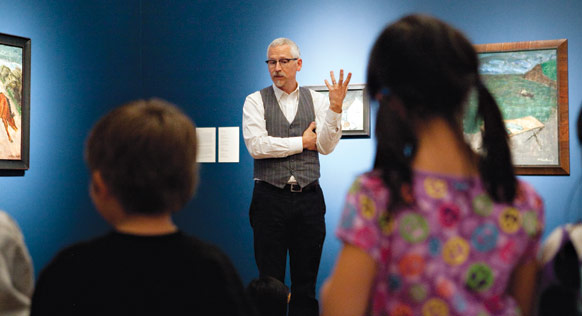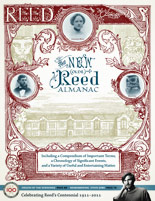
IRIS login | Reed College home Volume 90, No. 4: December 2011
Eliot Circular
The Art Spark

Photo by Vivian Johnson
Reed steps in to fill a void in local schools’ art programs.
By Lucy Bellwood ’12
They come galloping across the canyon bridge in a shrieking tidal wave of enthusiasm—two dozen third-graders on a field trip to Reed’s Cooley Gallery. As they approach the stately entrance to the Hauser Library, they swarm around a dapper gent in a pinstripe vest sporting an elegant mustache. He is Greg MacNaughton ’89, the official shepherd of the Open Gallery Program.
“Greg! We saw a heron in the canyon!” “I told you it wasn’t a pelican.” “Yeah, it was a blue heron!” “And weathergrams!” A word from Greg renders them instantly silent. He welcomes them back to the gallery in a calm, lilting tone, explaining that they’ll be building on the introduction to the calligraphy of Lloyd Reynolds [English and art 1929–69] that he gave them a day before. Stepping into the gallery, he leads them into another world—a world they might otherwise never venture into.
Gallery director Stephanie Sakellaris Snyder ’91 founded the Open Gallery program in 2004, with the goal of offering free, rigorous education in art and art history to local schoolchildren at a time when public schools were slashing their art programs. Since then, the gallery has engaged more than 10,000 students from Portland public schools by raising almost $60,000 in grants from the Oregon Cultural Trust, the Jackson Foundation, the Regional Arts and Culture Council, the Robert Lehman Foundation, and President Colin Diver.
“The Open Gallery program offers K-12 students the chance to engage in close, sustained observation of a wide variety of contemporary and historical works of art,” Stephanie says.
Stephanie and Greg first met as students at Reed. Years later, when she was looking for someone to help with the gallery’s outreach efforts, she thought of him. A religion major at Reed, he worked for many years as a case manager for homeless youths, often using art as a way to broach ethical and philosophical issues and rekindle their interest in returning to school. Last year, Stephanie succeeded in securing his position as the Cooley’s education outreach coordinator, thanks to Reed’s renewed commitment to reaching out to Portland kids.
Today’s students hail from Grout Elementary in Southeast Portland, which offers no art classes at all. They spill into the gallery with impressive familiarity, sitting on the floor to discuss the myriad objects representing Reynolds’s life and work. This is their third visit to the gallery this year—perhaps one of the program’s greatest assets. By building close ties with local schools, Greg brings students back to the gallery again and again, cementing the principles of a conference-based approach to exploring art.
There is something about Reynolds’s mastery that captures the imaginations of the students. They goggle at the drawings of skulls, the delicate scripts, the reed pens and hand-carved puppets. One asks what happened to Reynolds. “Did he die,” she asks carefully, “or retire?”
Greg chuckles and explains that he did both, though in reverse order. But in his hands, simple queries such as these can be used as departure points for deeper questions. Does a work of art end with the artist? Is art always beautiful? How can two rectangles look like a barn? Soon the dialogue begins to sound a bit like a Hum conference—a model Stephanie and Greg kept in mind when they designed the program.
“We’re hooked,” says Grout teacher Jonathon Fischer. “We’d never be able to do something like this at our school—there’s just no money. But we can walk 10 minutes across the soccer field and get this amazing experience!” Fischer is particularly impressed by Greg’s ability to talk to students from a wide variety of socioeconomic backgrounds—72 percent of Grout’s students qualify for free or reduced-price meals, and 22 percent speak a language besides English at home. “I’ve seen other teachers flounder,” Fischer marvels, “but he never loses it.”
Professor Mary James [physics 1988–] witnessed the Open Gallery program first-hand as a chaperone for her son’s middle-school class. “Greg is a master pedagogue and a fine ambassador for the college,” she says. “My son and his classmates have been fortunate indeed to be a part of this program. As for me, I’ve learned a lot from Greg, both about art and teaching.”
Nor is the program limited to students. “Often the teachers themselves don’t feel comfortable talking about art,” Greg says. “So we’re providing a model for them as well.” Last summer the Cooley hosted a symposium for teachers from Portland public schools to strengthen their ability to teach from works of art.
By providing serious, hands-on engagement, the program challenges the conventional exclusivity of the art world. “I’m extremely proud of that,” Greg smiles. In an era where public school budgets are cut to the bone, it is hard to imagine where else these students would get a chance to experience extraordinary works of art—not to mention the library’s Dr. Seuss bathroom.


LATEST COMMENTS
steve-jobs-1976 I knew Steve Jobs when he was on the second floor of Quincy. (Fall...
Utnapishtim - 2 weeks ago
Prof. Mason Drukman [political science 1964–70] This is gold, pure gold. God bless, Prof. Drukman.
puredog - 1 month ago
virginia-davis-1965 Such a good friend & compatriot in the day of Satyricon...
czarchasm - 4 months ago
John Peara Baba 1990 John died of a broken heart from losing his mom and then his...
kodachrome - 7 months ago
Carol Sawyer 1962 Who wrote this obit? I'm writing something about Carol Sawyer...
MsLaurie Pepper - 8 months ago
William W. Wissman MAT 1969 ...and THREE sisters. Sabra, the oldest, Mary, the middle, and...
riclf - 10 months ago